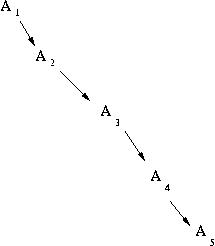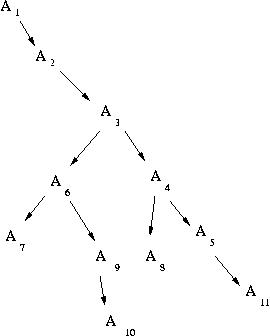The goal of this lab is to practice object-oriented design on a problem that will help you review the object-oriented features of Java and prepare for an exploration of object-oriented design techniques. A second purpose of this lab is to practice using subversion.
Object-oriented design is concerned with the relationship among classes and other types--- which classes implement which interfaces, which classes serve as components to other classes (by means of instance variables), and (as we will learn about soon) which classes share code by inheritance or composition.
You will practice doing object-oriented design (and think about how revision control works) by designing your own simple version control system. You will write a program that presents the user with a simple text area to edit. The user can "commit" changes made to the text area; these changes are saved in memory and assigned a version number, and the user can then go back to them later.
The user interface is a window that looks like this:

The "current" and "max" indicator at the top should display the version number of the currently displayed version (besides any changes that have been made since the last commit or recall) and the highest version number that has been assigned, respectively. When the program starts up, these should read "Current: 0" and "Max: 0", not "Current" and "Max" as the image shows.
When the user enters some text and then presses the "commit" button, the current and max counters should increment. Suppose the user then enters more text and presses "commit" again. If the user then presses the "<" button, the text should then revert to its state when the "commit" button was pressed the first time. Pressing the ">" button will change the text to what it was when "commit" was pressed the second time. In this way the user can shuffle though versions. Pressing "<" when the current indicator is 0 does nothing, and pressing ">" when the current indicator is equal to the max does nothing.
That specification would be adequate (and the problem very easy) if all the revisions were made in a linear fashion, and the user commited changes made only on the latest version-- in which case we would have an organization like

But what should happen if the user flips back to an earlier version, makes changes, and commits? Should the new version simply be put at the end of the chain, even though it does not descend from the latest version? Should the new version replace the version that used to come after the version that was edited, and the rest of the chain be lost?
Instead of the two options mentioned, your program should consider the series of versions to branch at this point. The new version will receive the next verions number (ie, the max version plus one), but instead of conceptually coming after the most recent version, it will be considered to branch off from the version it was derived from.
Suppose the user takes the collection of versions illustrated above, and then navigates back to version 3, makes a change, and commits (creating version 6). Then he makes another change (to the new version 6) and commits it as version 7. Then navigates to 4, changes and commits, navigates back to 6 and makes to changes in a row, and navigates to version 5 to make and commit a final change. That would result in the following tree of versions.

At this point, your version navigation feature should work as follows: When at version 6, pressing the "<" button will bring up version 3, the parent. Pressing ">" (at version 6) would bring up verion 9, the most recent decendant. The move among "sibling" versions, the user would use the "-" button; so, pressing the "-" button at version 6 would bring up version 4, and pressing "-" again would bring back version 6. If there are more than two siblings, the "-" should move from the most recent to the oldest, in a circular manner.
After making a new directory for this lab, use subversion to checkout code for this project.
svn checkout file:///homeemp/tvandrun/svn/######/lab3
where ###### is jessicajan or
samchet.
A class creating the window and an interface for that class
are provided.
ConcreteVCWindow implements VCWindow.
It also has a constructor with no parameters which will cause the window
to appear.
Your task is to write the rest of this program. You should first discuss the design and strategy with your partner; then I recommend that you each have a version checked out and work concurrently on different parts of the program. An important part of this is designing the class structure; the algorithm will fit around that.
Commit your final changes to subversion. You do not need to turn in a hard copy.